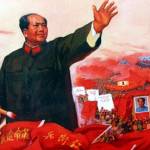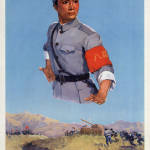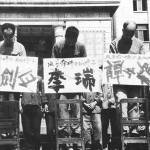
I’ve been enjoying Qiu Xiaolong‘s series of mystery novels set in Shanghai in the 1990s. One thing I like is Xiaolong’s ability to recreate a culture in transition, with characters of the generation of the Cultural Revolution interacting with characters of the liberalizing and modernizing generation.
Early in the Death of a Red Heroine, the main character, the young chief inspector Chen, is hosting a small, private party to celebrate his finally getting his own apartment. Someone puts on some music and begins dancing. The narrator comments:
“During the Cultural Revolution, the only thing close to dancing for the Chinese people was the Loyal Character Dance. People would stamp their feet in unison, to show their loyalty to Chairman Mao. … not until the mid-eighties could Chinese people dance without fear of being reported to the authorities.”[1]
Later, Chen is trying to understand the apparently ascetic, romance-less life of a young, political worker woman who has been murdered, and a reference to Madam A Qin is made:
 “Madam A Qin was a well-known character in Shajiabang, a modern Beijing opera performed during the Cultural Revolution, when any romantic passion — even that between husband and wife — had been considered to detract from people’s political commitment.”[2]
“Madam A Qin was a well-known character in Shajiabang, a modern Beijing opera performed during the Cultural Revolution, when any romantic passion — even that between husband and wife — had been considered to detract from people’s political commitment.”[2]
I am reminded of Nien Cheng’s autobiography, Life and Death in Shanghai, her eye-opening account of living through the Cultural Revolution, when museums and art galleries were shut down, older works of art and craft traditions were destroyed, and any element of individuality in expression or lifestyle was suppressed.[3]
So sayeth the Great Leader: Unity, not uniqueness. The communal, not the individual. Duty, not pleasure. Conformity, not self-creation and self-expression.
One great oddity in the twentieth-century art world is how many Western artists paid homage to Mao even though they would have been among the first to be suppressed, tortured, and killed under Maoism. Andy Warhol’s series of monumental paintings of Mao is one example. (Of course, Warhol was a jaded practitioner of cultural irony, and his primary purpose may have been to take cultural icon and, from a safe distance of 6,600 miles, turn him into another money-maker.)
The same holds for the many Western intellectuals who became Maoists, despite the fate of intellectuals under Mao’s regime. Cheng reports one young revolutionary’s forecast for the thinkers: 
“[They] are being investigated. Some of them are also class enemies. In any case, they are intellectuals. Our great leader has said, ‘The capitalist class is the skin; the intellectuals are the hairs that grow on the skin. When the skin dies there will be no more hair.’ The capitalist class nourishes the intellectuals, so they belong to the same side. Now we are going to destroy the capitalists. Naturally the intellectuals are to be destroyed too.”[4]
Artists, intellectuals, and politics, indeed.
Sources:
[1] Death of a Red Heroine (Soho Press, 2000), p. 19.
[2] Death of a Red Heroine, p. 71.
[3] Nien Cheng, Life and Death in Shanghai (Grove Press, 1986).
[4] Life and Death in Shanghai, p. 76.
The poster image from Shajiabang is from ChinesePosters.net. The image of university professors about to be executed is taken from Harun Yahya’s site.
Related:
Collectivizing sex — Alexandra Kollontai’s communist version.
Dr. Franz Hamburger and the Nazi collectivizing of reproduction.